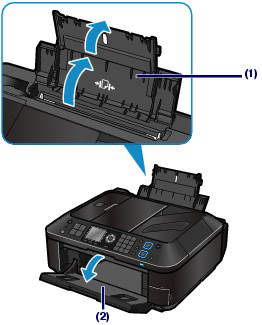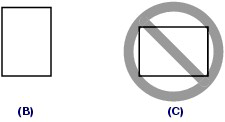Things to check when unable to send faxes - MX420
| Article ID: ART110244 | | | Date published: 05/11/2015 | | | Date last updated: 12/09/2015 |
Description
Solution
Cannot Send a Fax
| Checklist | ||
|
1: Is the power turned on?
A: ON button
B: FAX Memory lamp
important:
Confirm that all lamps on the Operation Panel are off before unplugging the power cord, then unplug the power cord.
If a power failure occurs or you unplug the power cord, all faxes stored in the machine's memory are deleted.
reference:
If the faxes stored in machine's memory are deleted by a power failure or unplugging the power cord, the list of the faxes deleted from the machine's memory will be printed after turning the machine on. |
||
2: Is the document being sent from memory or the fax being received into memory?
When the message for the transmission/reception is displayed on the LCD, a fax is being sent from/received into machine's memory. Wait until the transmission/reception is complete.
If the sending faxes is not complete or the machine was not able to print the received faxes, these faxes are stored in machine's memory.
If an error occurred during a fax transmission, the document is not stored in machine's memory.
In the following cases, the machine is not able to print the received fax and will automatically store the fax in its memory.
important:
You can print or delete the faxes stored in machine's memory. You can also save the received faxes stored in machine's memory on the memory card or the USB flash drive.
-> [ Printing a document in machine's memory: ]
-> [ Deleting a Document in Machine's Memory ]
-> [ Saving a Document in Machine's Memory to a Memory Card/USB Flash Drive ]
reference:
When confirming, printing, or deleting a document stored in machine's memory, you specify it by its transaction number. If you do not know the transaction number for your target document, print the list of documents first.
For details on how to print the list of documents, see [ Printing a List of the Document in Machine's Memory ].
Printing a Document in Machine's Memory
You can print a specified document in machine's memory or print all the documents in its memory at a time.
When printing a specified document, you specify it by its transaction number. If you do not know the transaction number for your target document, print the list of documents first.
- Printing a List of the Document in Machine's Memory
- Printing a Specified Document in Machine's Memory
- Printing All the Documents in Machine's Memory
reference:
- Printing a List of the Document in Machine's Memory
Print the list of the documents following the procedure below.
1. Make sure that the machine is turned on.
2. Load paper.
3. Press the FAX button.
The Fax standby screen is displayed.
4. Press the left FunctiON button.
The Fax menu screen is displayed.
5. Select
reference:
If no document is stored in machine's memory, There is no document in memory. is displayed. Press the OK button to return to the previous screen.
6. Use the
7. Use the
The list of documents stored in machine's memory is printed.
reference:
A transaction number from "0001" to "4999" indicates a document being sent. A transaction number from "5001" to "9999" indicates a document being received.
- Printing a Specified Document in Machine's Memory
Specify the document and print it following the procedure below.
1. Make sure that the machine is turned on.
2. Load paper.
3. Press the FAX button.
The Fax standby screen is displayed.
4. Press the left FunctiON button.
The Fax menu screen is displayed.
5. Select
6. Use the
The document selection screen is displayed.
A. Date and time of transaction and fax/telephone number
B. Transaction number (TX/RX NO.)
A transaction number from "0000" to "4999" indicates a document being sent.
A transaction number from "5001" to "9999" indicates a document being received.
C. Color information
Color is displayed for color transmission/reception. Nothing is displayed for black & white transmission/reception.
7. Use the
The confirmation screen is displayed.
8. Use the
- Printing All the Documents in Machine's Memory
Print all the documents in machine's memory following the procedure below.
1. Make sure that the machine is turned on.
2. Load paper.
3. Press the FAX button.
The Fax standby screen is displayed.
4. Press the left FunctiON button.
The Fax menu screen is displayed.
5. Select
6. Use the
The confirmation screen is displayed.
7. Use the
All the documents in machine's memory will be printed.
Each time a document is printed, the screen to confirm whether to delete the printed document in machine's memory is displayed.
If you select Yes using the
Deleting a Document in Machine's Memory
You can delete a specified document in machine's memory or delete all the documents in its memory at a time.
- Deleting a Specified Document in Machine's Memory
- Deleting All the Documents in Machine's Memory
reference:
When deleting a specified document, you specify it by its transaction number. If you do not know the transaction number for your target document, print the list of documents first.
-> [ Printing a List of the Document in Machine's Memory ]
- Deleting a Specified Document in Machine's Memory
Specify the document and delete it following the procedure below.
1. Make sure that the machine is turned on.
2. Press the FAX button.
The Fax standby screen is displayed.
3. Press the left FunctiON button.
The Fax menu screen is displayed.
4. Select
5. Use the
The document selection screen is displayed.
A. Date and time of transaction and fax/telephone number
B. Transaction number (TX/RX NO.)
A transaction number from "0001" to "4999" indicates a document being sent.
A transaction number from "5001" to "9999" indicates a document being received.
C. Color information
Color is displayed for color transmission/reception. Nothing is displayed for black & white transmission/reception.
6. Use the
The confirmation screen is displayed.
7. Use the
The specified document will be deleted from machine's memory.
reference:
- Deleting All the Documents in Machine's Memory
Delete all the documents in machine's memory following the procedure below.
reference:
This function is not available while the machine is receiving a fax.
1. Make sure that the machine is turned on.
2. Press the FAX button.
The Fax standby screen is displayed.
3. Press the left FunctiON button.
The Fax menu screen is displayed.
4. Select
5. Use the
The confirmation screen is displayed.
6. Use the
All the documents in machine's memory will be deleted.
Saving a Document in Machine's Memory to a Memory Card/USB Flash Drive You can save the received faxes stored in machine's memory to a memory card or a USB flash drive as PDF files using the Operation Panel of the machine.
You can save a specified document in machine's memory to the memory card or the USB flash drive, or save all the documents in its memory to the memory card or the USB flash drive at a time.
- Saving a Specified Received Document in Machine's Memory to Memory Card/USB Flash Drive
- Saving All the Received Documents in Machine's Memory to Memory Card/USB Flash Drive
important:
reference:
-> [ Printing a List of the Document in Machine's Memory ]
- Saving a Specified Received Document in Machine's Memory to Memory Card/USB Flash Drive
Specify the received document and save it on the memory card or the USB flash drive following the procedure below.
1. Make sure that the machine is turned on.
2. Insert the memory card into the Card Slot or insert the USB flash drive into the Direct Print Port.
3. Press the FAX button.
The Fax standby screen is displayed.
4. Press the left FunctiON button.
The Fax menu screen is displayed.
5. Select
6. Use the
7. Use the
The document selection screen is displayed.
A. Date and time of transaction and fax/telephone number
B. Transaction number (TX/RX NO.)
A transaction number from "0001" to "4999" indicates a document being sent.
A transaction number from "5001" to "9999" indicates a document being received.
C. Color information
Color is displayed for color transmission/reception. Nothing is displayed for black & white transmission/reception.
8. Use the
The specified document is saved.
reference:
- Saving All the Received Documents in Machine's Memory to Memory Card/USB Flash Drive
Save all the documents in machine's memory to the memory card or the USB flash drive following the procedure below.
1. Make sure that the machine is turned on.
2. Insert the memory card into the Card Slot or insert the USB flash drive into the Direct Print Port.
3. Press the FAX button.
The Fax standby screen is displayed.
4. Press the left FunctiON button.
The Fax menu screen is displayed.
5. Select
6. Use the
7. Use the
All the documents in machine's memory will be saved to the memory card or the USB flash drive.
reference:
- Folder name: CANON_SC\FAXDOC\0001
- File name (file extension: PDF): Running numbers, starting from FAX_0001
- File date: The date and time of saving as set in the machine.
You can import faxes saved on a memory card to the computer using the Card Slot on the machine.
You can import faxes saved on a USB flash drive to the computer.
After saving faxes, connect the USB flash drive to the computer, then import the data. |
||
3: Is the telephone line connected to the External Device Jack?
Reconnect it to the Telephone Line Jack. Preparation
important:
1.
Make sure all the following items are supplied.
(1) FINE cartridges (Color, Black)
(2) Power cord
(3) Telephone line cable
(4) Manuals
(5) Setup CD-ROM (containing the drivers, applications and on-screen manuals)
(6) Other documents
reference:
Do not connect the power cord yet.
2.
Remove all the protective materials and orange tape from the outside of the machine.
3.
(1) Open the Paper Output Tray (A).
(2) Make sure the Document Cover (B) is closed, then lift to open the Scanning Unit (Cover) (C).
(3) Fix it with the Scanning Unit Support (D).
4.
Remove the orange tape (E) and the protective material (F) carefully.
5.
(1) Lift the Scanning Unit (Cover) slightly.
(2) Fold the Scanning Unit Support.
(3) Close the Scanning Unit (Cover) gently.
Use fax features?
Yes -> Go to 6
No -> Go to 8
6.
Connect one end of supplied telephone line cable (G) to the lower connector labeled "L" on the machine, and then connect the other end to the telephone jack on the wall (H).
important:
If you cannot send faxes after installing the machine, check the following:
1. The telephone line cable is connected to connector labeled "L" on the machine.
2. The dial tone at the telephone jack on the wall.
3. The telephone line type.
reference:
The basic connection method is described here.
7.
Only when connecting a telephone or an answering machine
Remove the Cap (I) (1), then connect a telephone or an answering machine with the telephone line cable (2).
important:
8.
Insert the power cord into the connector on the machine and into the wall outlet firmly.
important:
Do NOT connect the USB cable or Ethernet cable at this stage.
9.
Press the ON button (J) to turn on the machine.
reference:
It takes about 5 seconds for the ON button to work after the power cord is plugged in.
10.
Use the
important:
If you want to change the language shown on the LCD, press the Back button (M) to return to the Language selection screen.
11.
When this screen is displayed, proceed to the next step.
important:
When it is necessary to turn off the machine
Be sure to follow the procedure below.
(1) Press the ON button to turn off the machine.
(2) Make sure that all the lamps on the Operation Panel are not lit.
Operating noise may continue for up to 30 seconds until the machine turns off.
important:
When using the fax features
reference:
The specification of the power cord differs for each country or region. Install the FINE Cartridges 1.
(1) Make sure the Document Cover (A) is closed, then lift to open the Scanning Unit (Cover) (D).
(2) Fix it with the Scanning Unit Support (E).
important:
2.
The FINE Cartridge Holder (H) moves to the installation position.
If the FINE Cartridge Holder does not move, make sure that the machine is turned on.
For details, refer to 8 to 9 in [ Preparation ].
3.
Follow the next procedure to insert the Black
4. Open the Ink Cartridge Locking Cover
Pinch firmly and pull up the cover.
5.
After removing the Black FINE Cartridge
important:
6. Place the Black FINE Cartridge
important:
7.
Push down
View the Ink Cartridge Locking Cover
8.
Insert the Color FINE Cartridge
9.
(1) Lift the Scanning Unit (Cover) slightly.
(2) Fold the Scanning Unit Support.
(3) Close the Scanning Unit (Cover) gently.
10.
Wait for about 1 minute until the LCD changes as shown in the illustration, then proceed to the next step.
important:
reference:
Load Paper 1
Open the Paper Support (A).
2
Move the Paper Guides (B) to edges.
3
Load paper in the center of the Rear Tray (C).
Load paper in portrait orientation with the printing side facing up.
4
Slide the left and right Paper Guides against edges of the paper.
Make sure that the height of the paper stack does not exceed the line (D).
Set Up for Fax Reception
note:
Read this section only when using the fax features.
Depending on your needs, select one of the following three modes for receiving faxes. You can change the receive mode after installation is complete.
- Intended Use
-> TEL priority mode
Voice calls cannot be received unless a telephone is connected.
-> FAX only mode
-> DRPD
- Responses to Calls in Each Mode
Even when a telephone is connected to the machine, the telephone's ringtone may not sound for an incoming call depending on the telephone type or settings.
1
Press the FAX button (A).
2
Press the center FUNCTION button (B).
3
Use the
The fax standby screen returns.
The machine cannot send/receive faxes if the connection is incorrect. Connect the machine correctly.
important:
If the Power Disconnects Unexpectedly
If the power disconnects, the following will apply:
Connecting Various Lines These are examples and could not be guaranteed to suit every connecting condition. For details, refer to the instruction manual supplied with the network device (control devices such as an xDSL (Digital Subscriber Line) modem or terminal adapter) you are connecting to this machine.
important:
Do not connect fax machines and/or telephones in parallel (US and Canada only)
- If you pick up the handset of the telephone that is connected in parallel during fax transmission or reception, the fax image may be corrupted or a communication error may occur.
- Such services as Caller ID, etc. may not operate properly on the telephone.
reference:
Connecting the telephone
For users in the UK
Attach the B.T. adapter to the modular cable connecting the external device, then connect the B.T. adapter to the
- Connecting to an Internet Telephone
(A) Digital Subscriber Line
(B) xDSL modem (splitter may not be built-in to the modem)
(C) WAN (Wide Area Network)
(D) Broadband router compatible with Internet Telephone
(E) Computer
(F) Telephone or answering machine
(G) LAN (Local Area Network)
(H) TEL
(I) LINE
* Port configurations and names may vary depending on the product.
reference:
See [ Setting the Telephone Line Type ].
- Connecting to an xDSL
(A) Analog Subscriber Line
(B) xDSL modem (splitter may not be built-in to the modem)
(C) Computer
(D) Telephone or answering machine
important:
reference:
See [ Setting the Telephone Line Type ].
- Connecting to an ISDN Line
For details on ISDN (Integrated Service Digital Network) connection and settings, refer to the manuals supplied with your terminal adapter or dial-up router.
Setting the Telephone Line Type
Before using your machine, make sure you set the correct telephone line type for your telephone line. If you are unsure of your telephone line type, contact your telephone company. For xDSL or ISDN connections, contact the telephone company or service provider to confirm your line type.
reference:
1. Display the [ Telephone line type ] screen.
(1) Press the [ Setup ] button.
(2) Select [ Device settings ]
(3) Select [ FAX settings ] , and press the OK button.
(4) Select [ FAX user settings ] , and press the OK button.
(5) Select [ Telephone line type ] , and press the OK button.
2. Select the telephone line type.
(1) Select the telephone line type.
Rotary pulse: Suitable for pulse dialing.
Touch tone: Suitable for tone dialing.
(2) Press the OK button.
3. Press the FAX button to return to the fax standby screen. |
||
4: Is the telephone line type set correctly?
|
||
5: Is Hook key setting set to Disable?
When you send a fax manually, dial the number with [ Enable ] selected for [ Hook key setting ] in [ Security control ] under [ FAX settings ], or dial the number using the telephone connected to the machine. |
||
6: Is Dial tone detect set to ON?
Resend the fax after a while.
If you still cannot send the fax, select [ OFF ] for [ Dial tone detect ] in [ Advanced FAX settings ] under [ FAX settings ]. |
||
7: Is the fax number registered correctly for speed dialing?
Check the recipient's fax/telephone number, correct the fax/telephone number registered to the speed dial code, then send the document again.
reference:
You can check the information for speed dialing by printing the telephone number list.
Speed dialing allows you to dial fax/telephone numbers by simply pressing a few buttons.
The following speed dialing methods are available:
reference:
Registering Recipients to Coded Speed Dial Before you can use the coded speed dialing feature, you need to register the recipients' fax/telephone numbers. Follow the procedure below to register the recipients' fax/telephone numbers.
1. Make sure that the machine is turned on.
2. Press the [ FAX ] button.
The Fax standby screen is displayed.
3. Press the left FunctiON button.
The Fax menu screen is displayed.
4. Select
5. Use the
The screen to select a coded speed dial code is displayed. 
reference:
6. Use the
7. Use the
reference:
8. Enter the recipient's name.
If you select a name on [ From incoming call log ] in step 7, the name may be already entered. If you do not change the name, move the cursor to [ TEL no. ], then go to step 10.
reference:
9. Enter the recipient's fax/telephone number.
If you select a fax/telephone number on From outgoing call log or From incoming call log in step 7, the fax/telephone number is already entered. If you do not change the fax/telephone number, move the cursor to [ TEL no. ], then go to step 10.
reference:
10. Finalize registration.
Press the OK button.
reference:
Registering Recipients for Group Dial
If you register two or more registered coded speed dial codes to a group dial, you can send the same document successively to all recipients registered to the group dial.
1. Make sure that the machine is turned on.
2. Press the FAX button.
The Fax standby screen is displayed.
3. Press the left FunctiON button.
The Fax menu screen is displayed.
4. Select
5. Use the
The screen to select a group dial code is displayed. 
reference:
If you select a code already used as a coded speed dial, [ (Not available) ] is displayed next to the code. If you select a code already used as a group dial, the registered group name is displayed.
6. Use the
The screen to register the group name and the member of the group is displayed. 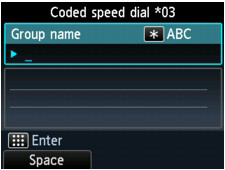
7. Enter the group name.
8. Register the members.
reference:
reference:
9. Press the OK button to finalize registration.
reference:
|
||
8: Does an error occur during transmission?
|
||
9: Is the document loaded properly?
Remove the document, then reload it on the Platen Glass or in the ADF. Loading Plain Paper / Photo Paperimportant:
reference:
1. Prepare paper.
Align the edges of paper. If paper is curled, flatten it. 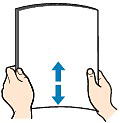
reference:
2. Load paper.
(1) Open the Paper Support, and open the support as an extension.
(2) Open the Paper Output Tray gently.
(3) Slide the Paper Guides (A) to open them, and load the paper in the center of the Rear Tray WITH THE PRINT SIDE FACING YOU.
(4) Slide the Paper Guides (A) to align them with sides of the paper stack.
Do not slide the Paper Guides too hard. The paper may not be fed properly. 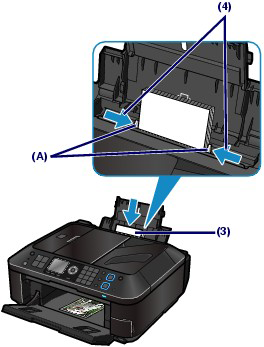
important:
reference:
reference:
- After loading paper
Loading Originals in the ADF You can load documents to copy, fax, or scan in the ADF.
reference:
1. Make sure that any original has been removed from the Platen Glass.
2. Load a document in the ADF.
(1) Open the Document Tray.
(2) Insert the document in the Document Tray until you hear a beep sound.
Load the document WITH THE SIDE TO SCAN FACING UP in the Document Tray.
reference:
(3) Adjust the Document Guides to match the width of the document.
Do not slide the Document Guides too hard. The document may not be fed properly.  |
||
10: Does a printer error occur?
Check the error message on the LCD, then resolve the problem.
If you are in a hurry, press the Stop button to close the message, then send the fax. |
||
11: Is the telephone line connected correctly?
Check that the telephone line is connected correctly to the proper jack. If so, then there is a problem with your telephone line. Contact your telephone company and the manufacturer of your terminal adapter or telephone adapter. |


 Memory reference, then press the OK button.
Memory reference, then press the OK button.
 button to select Print memory list, then press the OK button.
button to select Print memory list, then press the OK button. Memory reference, then press the OK button.
Memory reference, then press the OK button.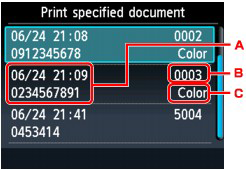
 Memory reference, then press the OK button.
Memory reference, then press the OK button. Memory reference, then press the OK button.
Memory reference, then press the OK button.
 Memory reference, then press the OK button.
Memory reference, then press the OK button. Memory reference, then press the OK button.
Memory reference, then press the OK button.




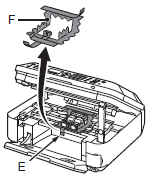




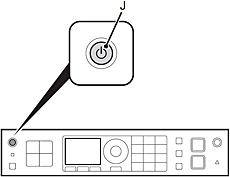






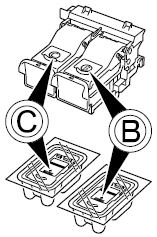
 and Color
and Color  FINE Cartridges into their corresponding slots
FINE Cartridges into their corresponding slots  on the right side.
on the right side.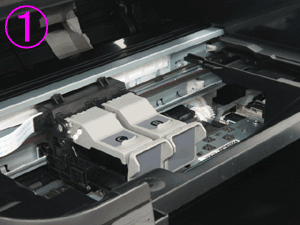

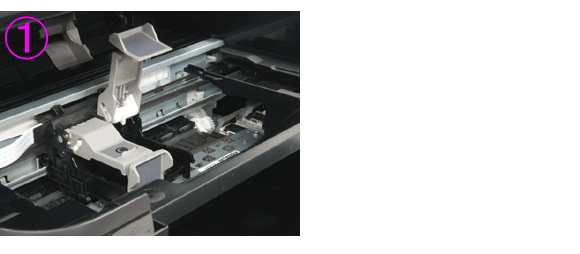




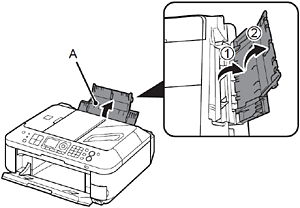



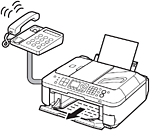



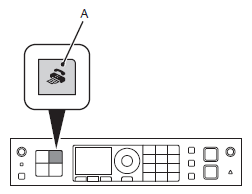

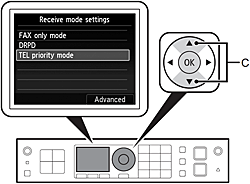

 (External device) jack.
(External device) jack.


 , and press the OK button.
, and press the OK button.
 [ TEL number registration ], then press the OK button.
[ TEL number registration ], then press the OK button.


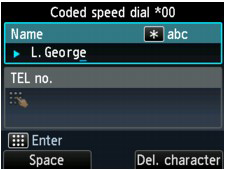
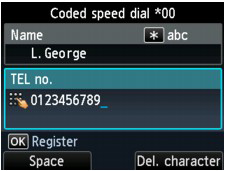
 [ TEL number registration ], then press the OK button.
[ TEL number registration ], then press the OK button.



